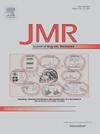Design of planar transmission line microwave probes for broadband EPR spectroscopy
IF 1.9
3区 化学
Q3 BIOCHEMICAL RESEARCH METHODS
引用次数: 0
Abstract
In broadband transmission-based electron paramagnetic resonance (EPR) spectrometers, non-resonant planar microwave probes play a key role, but very few systematic explorations of their design space exist. We develop design guidelines for two common types of transmission lines, microstrip and coplanar waveguide, to achieve a high effective microwave magnetic field strength, which ultimately leads to a more sensitive EPR measurement set-up. We compare the optimized transmission line structures and show that the coplanar waveguide achieves a higher simulated effective magnetic field strength. The simulation results are confirmed by EPR measurements up to a microwave frequency of 45 GHz.

宽带EPR光谱用平面传输线微波探头的设计
在基于宽带传输的电子顺磁共振(EPR)光谱仪中,非共振平面微波探针起着关键作用,但对其设计空间的系统探索还很少。我们为两种常见类型的传输线,微带和共面波导制定了设计指南,以实现高效的微波磁场强度,最终导致更敏感的EPR测量设置。比较了优化后的传输线结构,结果表明共面波导具有较高的模拟有效磁场强度。仿真结果得到了微波频率为45 GHz的EPR测量结果的验证。
本文章由计算机程序翻译,如有差异,请以英文原文为准。
求助全文
约1分钟内获得全文
求助全文
来源期刊
CiteScore
3.80
自引率
13.60%
发文量
150
审稿时长
69 days
期刊介绍:
The Journal of Magnetic Resonance presents original technical and scientific papers in all aspects of magnetic resonance, including nuclear magnetic resonance spectroscopy (NMR) of solids and liquids, electron spin/paramagnetic resonance (EPR), in vivo magnetic resonance imaging (MRI) and spectroscopy (MRS), nuclear quadrupole resonance (NQR) and magnetic resonance phenomena at nearly zero fields or in combination with optics. The Journal''s main aims include deepening the physical principles underlying all these spectroscopies, publishing significant theoretical and experimental results leading to spectral and spatial progress in these areas, and opening new MR-based applications in chemistry, biology and medicine. The Journal also seeks descriptions of novel apparatuses, new experimental protocols, and new procedures of data analysis and interpretation - including computational and quantum-mechanical methods - capable of advancing MR spectroscopy and imaging.

 求助内容:
求助内容: 应助结果提醒方式:
应助结果提醒方式:


